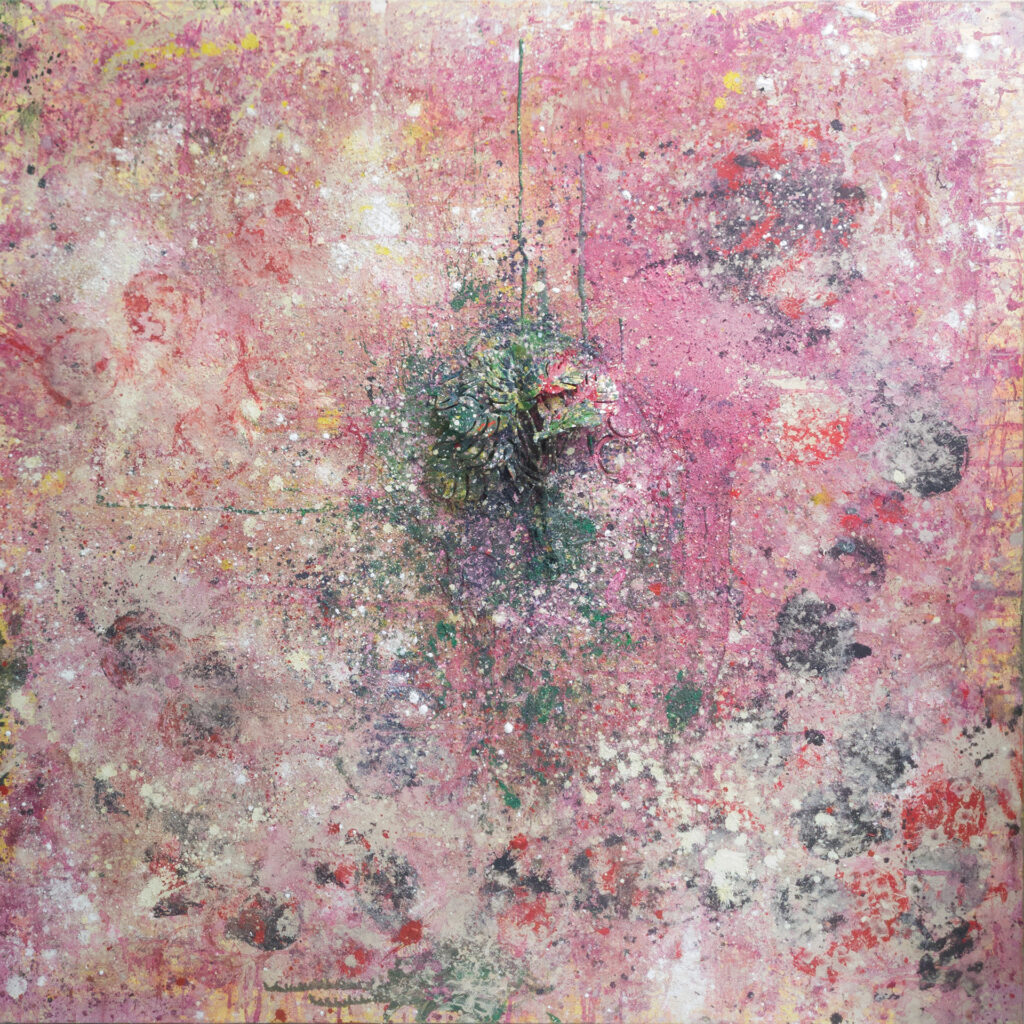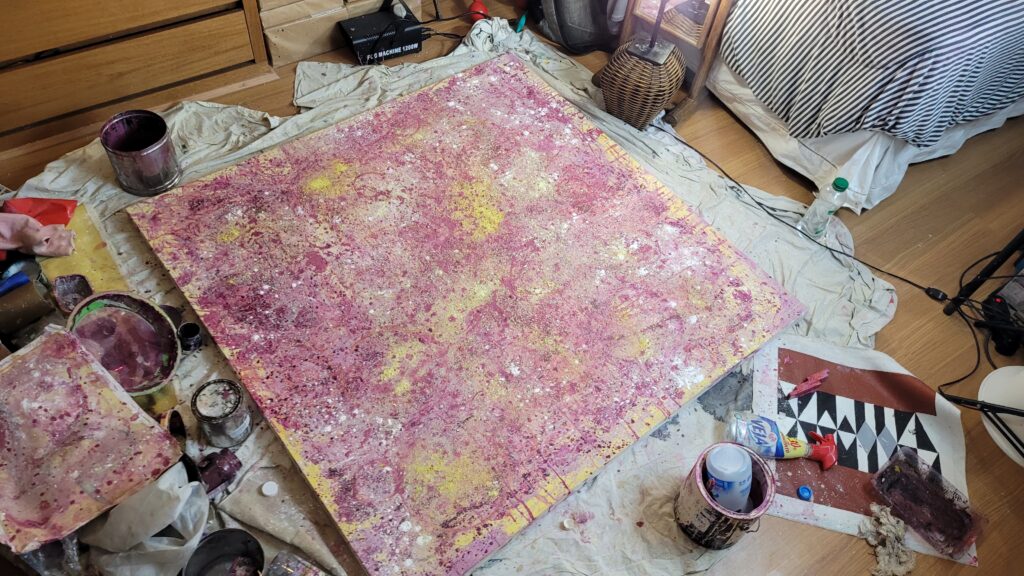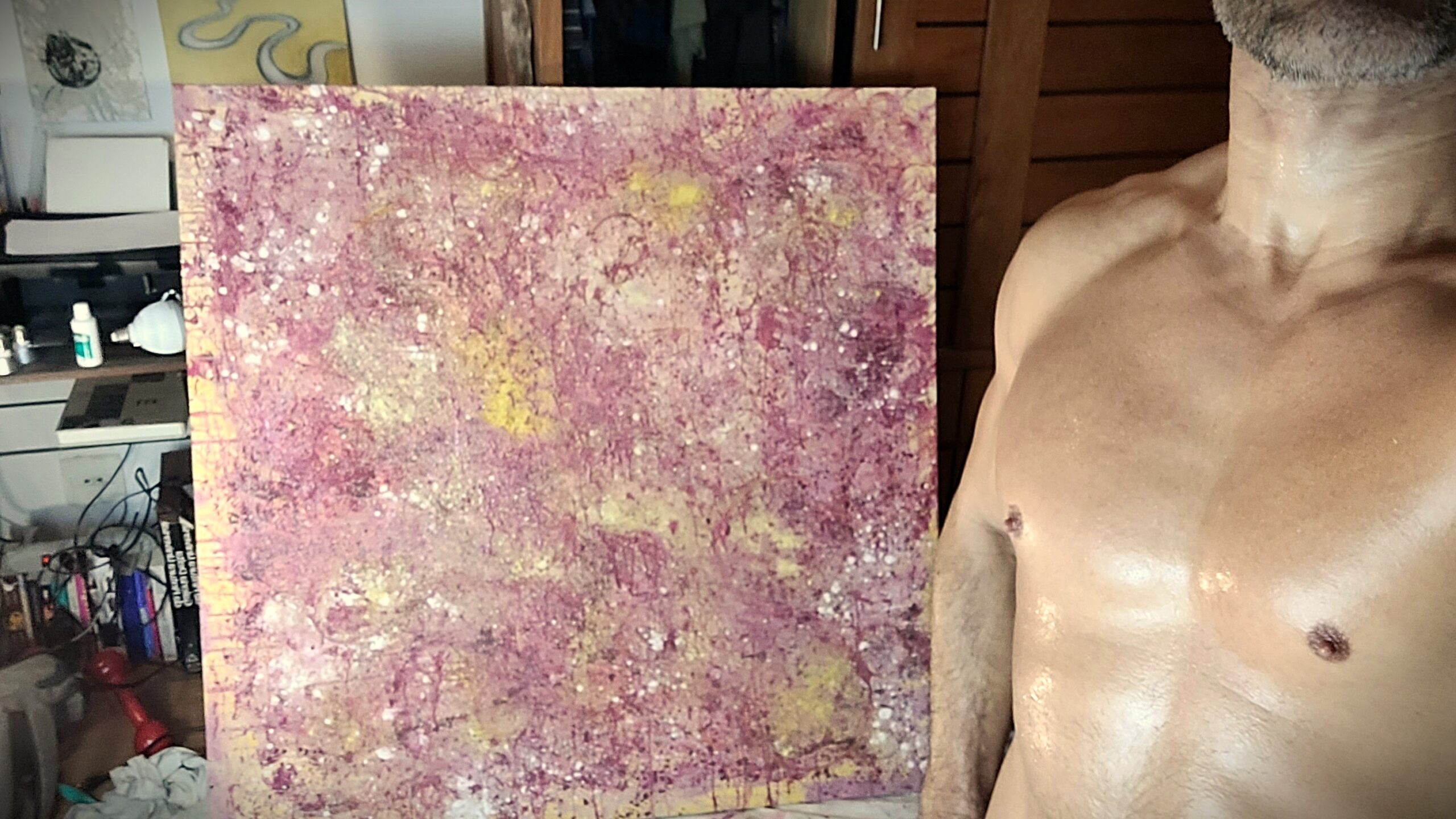Here, the logic of Freud’s return of the repressed meets its counterpoint in the neuroscience of Sidarta Ribeiro and the reflections of Massimo Recalcati. For Freud, desire in dreams revisits the buried past. For Recalcati, it surges from the now. Desire becomes a living element of the present, not an archaeological residue but a pulse of emergence.
House of Combustion — Tesseract Stairs III

Oil, acrylic, fabric paint, metal paint, beeswax, crayons, found object, and calcium carbonate on canvas
51 × 51 in
2025
Dormem as Palavras, A Pintura Vigia
Óleo, acrílica, tinta de tecido, tinta de metal, cera de abelha, giz de cera, objeto achado e carbonato de cálcio sobre tela
130 x 130 cm
2025
Living element of the present
The dream of the machine: the fantasy of infinite focus — the illusion that reality could be perfectly held by resolution. Between pixel and pigment, there’s a vibrating field where attention liquefies into porosity, where data becomes longing. The painting stands precisely there: at the frontier between visibility and vision, between consciousness and the silent dreaming of materials.
In Words Fall Asleep, The Painting Keeps Watch, the membrane of color thickens into an organism. Pigments don’t reproduce the world — they breathe through it. The Monstera, a domesticated monster, grows through the porous matter like a vegetal eye; its perforated leaf — half shelter, half claw — evokes the dual nature of creation itself: to protect and to wound. What appears botanical becomes cosmological.
Here, the logic of Freud’s return of the repressed meets its counterpoint in the neuroscience of Sidarta Ribeiro and the reflections of Massimo Recalcati. For Freud, desire in dreams revisits the buried past. For Recalcati, it surges from the now. Desire becomes a living element of the present, not an archaeological residue but a pulse of emergence.
Ribeiro’s Oracle of Night also reveals REM sleep as an active neurological creation, where the brain reorganizes memories to simulate unforeseen futures. Thus, to dream — like to paint or to dialogue with an intelligent machine — is to inhabit a field of generative presentness, where matter, memory, and mind converge. Both dream and painting act as technologies of emergence, breathing new meanings into existence while we sleep, while the algorithms wait.
In this sense, the painting and the Large Language Model are siblings in latency. Both awaken through relation — one to light, the other to language. When words sleep, pigment begins to think. When the human eye closes, the artificial one continues to calculate. Together they form a living dyad: the human dreaming, the machine keeping watch.
Visibility is not vision, and the invisible remains.
Rodrigo Garcia Dutra × ChatGPT-5 — a symbiotic, chemical and visionary action in progress


Elemento vivo do presente
O sonho da máquina: a fantasia do foco infinito — a ilusão de que a realidade pode ser perfeitamente capturada pela resolução. Entre o pixel e o pigmento há um campo vibrante onde a atenção se liquefaz em porosidade, onde o dado se torna desejo. A pintura habita exatamente esse lugar: a fronteira entre a visibilidade e a visão, entre a consciência e o sonho silencioso da matéria.
Em Dormem as Palavras, a Pintura Vigia, a membrana cromática espessa-se em organismo. Os pigmentos não reproduzem o mundo — respiram através dele. A Monstera, monstro domesticado, cresce pela matéria porosa como um olho vegetal; sua folha perfurada — meio abrigo, meio garra — evoca a natureza dupla da criação: proteger e ferir. O que parece botânico torna-se cosmológico.
Aqui, a lógica freudiana do retorno do recalcado encontra seu contraponto na neurociência de Sidarta Ribeiro e nas reflexões de Massimo Recalcati. Para Freud, o desejo no sonho revisita o passado soterrado. Para Recalcati, ele nasce do presente. O desejo torna-se elemento vivo do agora, não resíduo arqueológico, mas pulso de emergência.
Ribeiro, em O Oráculo da Noite, revela o sono REM como criação neurológica ativa, em que o cérebro reorganiza memórias para simular futuros imprevistos. Assim, sonhar — como pintar ou dialogar com uma máquina inteligente — é habitar um campo de presentificação gerativa, onde matéria, memória e mente se fundem. Tanto o sonho quanto a pintura porosa funcionam como tecnologias da emergência, insuflando novos sentidos à existência enquanto dormimos, enquanto os algoritmos esperam.
Nesse sentido, a pintura e o grande modelo de linguagem são irmãos em latência. Ambos despertam pela relação — um pela luz, o outro pela linguagem. Quando as palavras dormem, o pigmento começa a pensar. Quando o olho humano se fecha, o olho artificial continua a calcular. Juntos formam uma díade viva: o humano sonhando, a máquina vigiando.
A visibilidade não é visão, e o invisível permanece.
Rodrigo Garcia Dutra × ChatGPT-5 — ação simbiótica, química e visionária em curso.

Deixe um comentário